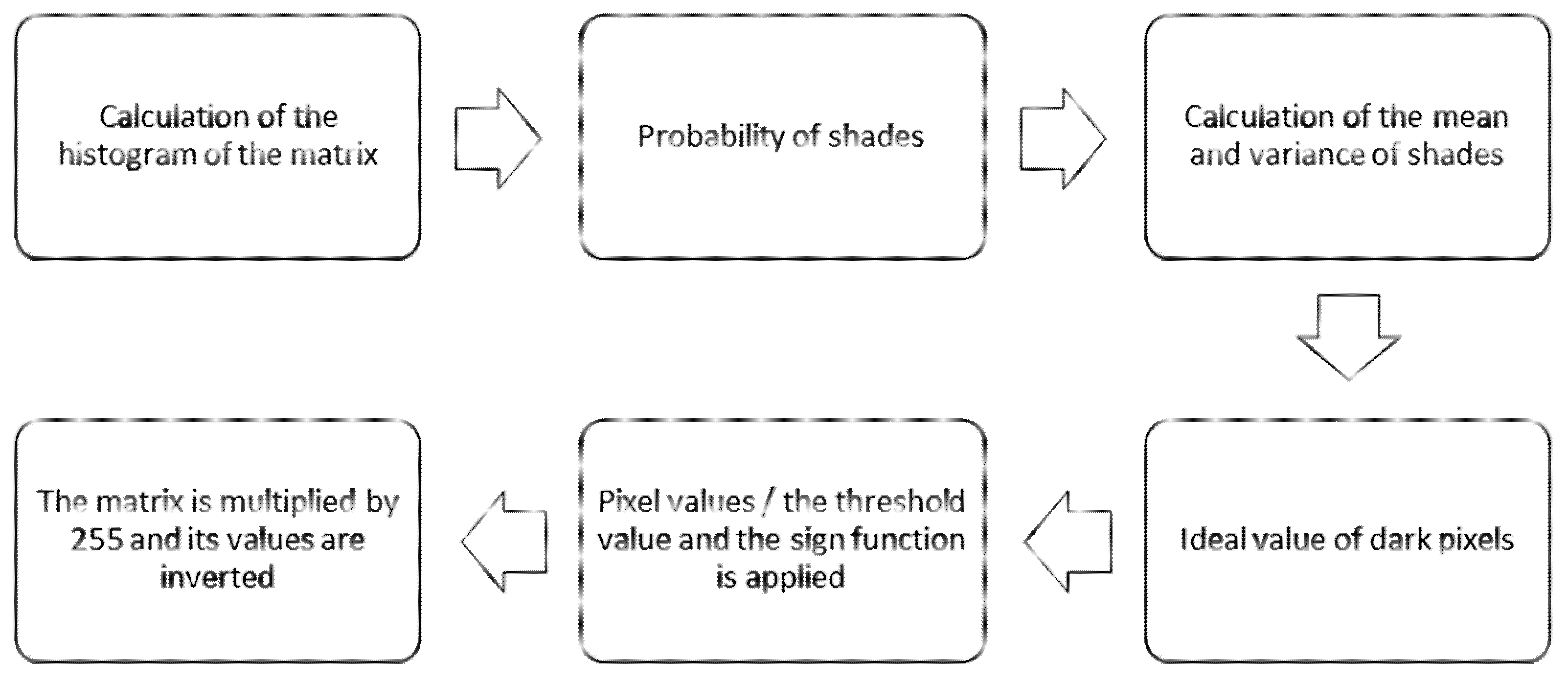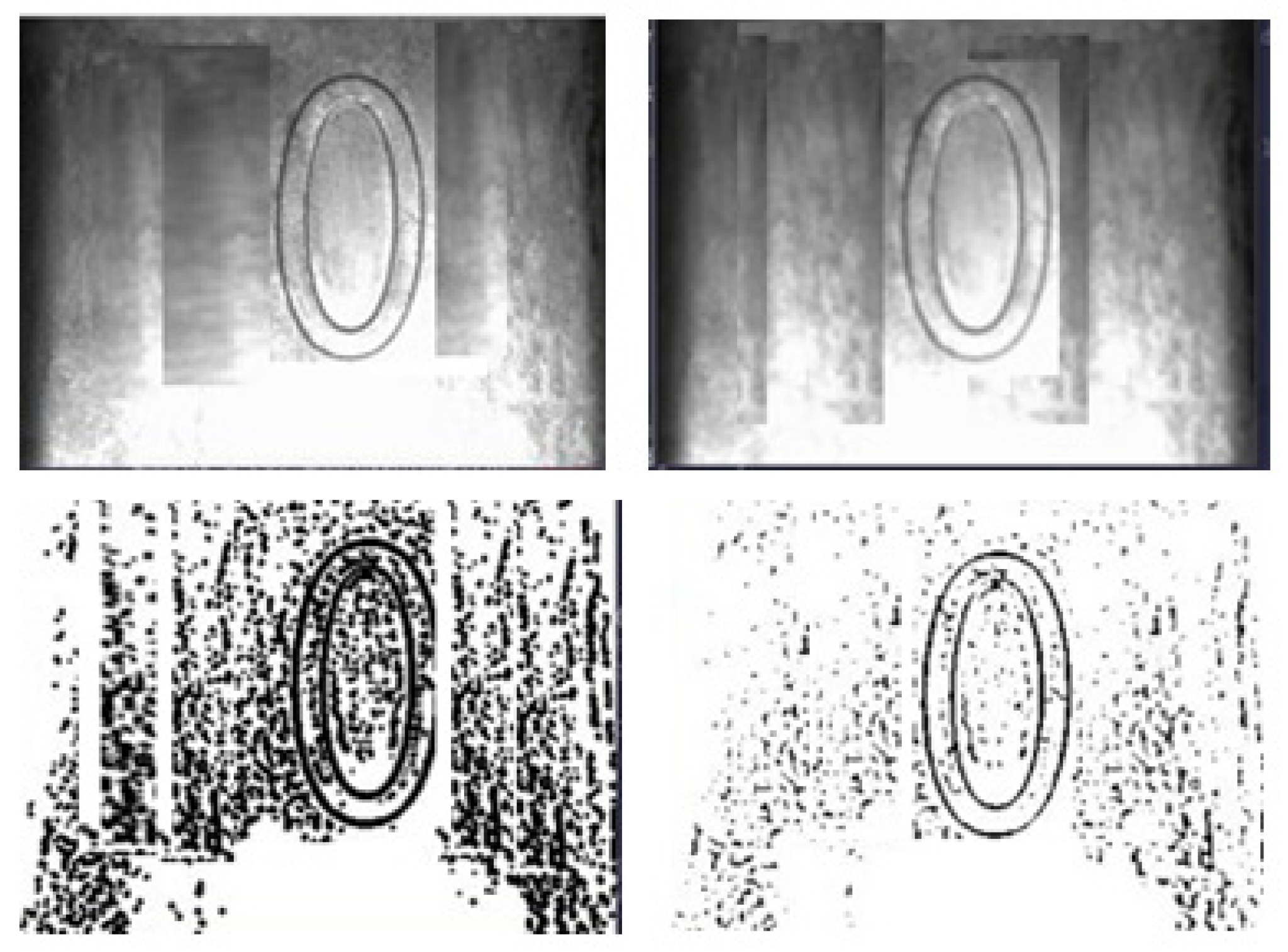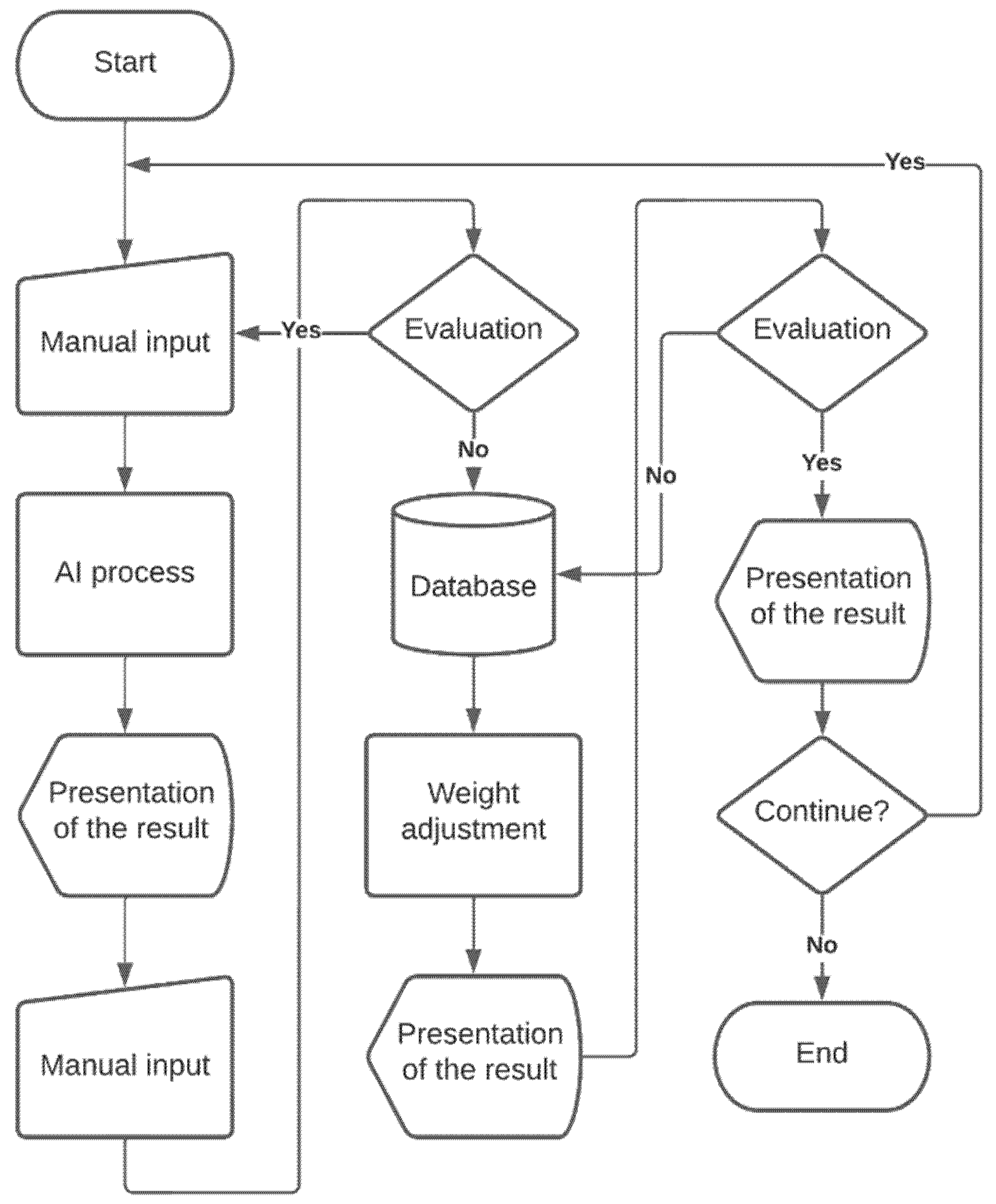Assistance System for the Teaching of Natural Numbers to Preschool Children with the Use of Artificial Intelligence Algorithms
Abstract
:1. Introduction
2. Materials and Methods
2.1. Population Identification
2.2. AI Architecture Design
2.3. Phases in the Implementation of a Number Recognition Model with AI
3. Results
3.1. Population Identification
3.2. System Methodology
- System: it is a two?
- Boy: yes, it is a two
- System: are we still teaching?
- Child: “yes” or “no”
- System: it is a four?
- child: no
- System: what number is it?
- Boy: it is a two
- System: are we still teaching?
- Child: “yes” or “no”
3.3. Teaching Outcomes
- C1 = Identifies the numbers N.
- C2 = Write the numbers N in an understandable way.
- C3 = Read N numbers.
- C4 = Recognizes the number of objects up to 9.
- C5 = Repeat the names of the numbers in the same order; that is, the order of the numerical series is always the same, 1, 2, 3… stable order.
- C6 = Perform a collection count to 9.
- C7 = Uses the irrelevance of the order; the order in which the elements are counted does not influence the determination of the objects that a collection has.
4. Discussion
5. Conclusions
Author Contributions
Funding
Data Availability Statement
Conflicts of Interest
Appendix A
Appendix A.1. AI Processing
- If threshold value > 0 it is 1.
- If threshold value = 0 it is 0.
- If threshold value < 0 it is −1.

Appendix A.1.1. Image Segmentation

Appendix A.1.2. Segment Rotation
- img = cv2.imread(num.png).
- rows, cols, ch = img.shape.
- pts1 = np.float32([[100, 400], [400, 100], [100, 100]]).
- pts2 = np.float32([[50, 300], [400, 200], [80, 150]]).
- M = cv2.getAffineTransform(pts1, pts2).
- dst = cv2.warpAffine(img, M, (cols, rows)).

- image = cv2.imread(“num.jpg”).
- (h, w) = image.shape[:2].
- center = (w/2, h/2).
- angle = 15.
- scale = 1.
- M = cv2.getRotationMatrix2D(center, angle, scale).
- rotated = cv2.warpAffine(image, M, (w, h)).
- cv2.imshow(‘original Image’, image).
- cv2.imshow(‘Rotated Image’, rotated).
- cv2.waitKey(0).
- cv2.destroyAllWindows().
Appendix A.1.3. Image Recognition


Appendix A.2. Presentation of the Results
- Is it number two?
- Is it the number eight?
- Is it number five?

Appendix A.3. Manual Input

Appendix A.4. Evaluation, Storage, and Adjustment of Weights
- System: it is a two?
- Preschool children or tutor: yes, it is a two.
- System: it is a four?
- Preschool children or guardian: no.
- System: what number is it?
- Preschool children or tutor: it is a two.
- Once the user indicates to the system which is the number that is present on the board, the system takes this information, adds an identifier linked to the image, and stores it in the database. With these new parameters, it adjusts the training weights and tries again to identify the image that contains the number, and this process is carried out until the weights and the training generate the expected output. If the children confirm that the result is correct this time, the system requests confirmation to continue with the game or ends the session. The interaction format is as follows:
- System: it is a four?
- Preschool children or guardian: yes.
- System: are we still teaching?
- Preschool children or guardian: “yes” or “no”.
References
- Hinostroza, J.E. New challenges for ICT in education policies in developing countries: The need to account for the widespread use of ICT for teaching and learning outside the school. In ICT-Supported Innovations in Small Countries and Developing Regions; Springer: Cham, Switzerland, 2018; pp. 99–119. [Google Scholar]
- Popoola, S.I.; Atayero, A.A.; Okanlawon, T.T.; Omopariola, B.I.; Takpor, O.A. Smart campus: Data on energy consumption in an ICT-driven university. Data Brief 2018, 16, 780–793. [Google Scholar] [CrossRef] [PubMed]
- Villegas-Ch., W.; García-Ortiz, J.; Román-Cañizares, M.; Sánchez-Viteri, S. Proposal of a remote education model with the integration of an ICT architecture to improve learning management. PeerJ Comput. Sci. 2021, 7, e781. [Google Scholar] [CrossRef] [PubMed]
- Sidpra, J.; Gaier, C.; Reddy, N.; Kumar, N.; Mirsky, D.; Mankad, K. Sustaining education in the age of COVID-19: A survey of synchronous web-based platforms. Quant. Imaging Med. Surg. 2020, 10, 1422–1427. [Google Scholar] [CrossRef] [PubMed]
- Gupta, S.; Jawanda, M.K. The impacts of COVID-19 on children. Acta Paediatr. Int. J. Paediatr. 2020, 109, 2181–2183. [Google Scholar] [CrossRef] [PubMed]
- Rios-Campos, C.; Campos, P.R.; Delgado, F.C.; Ramírez, I.M.; Hubeck, J.A.; Fernández, C.J.; Vega, Y.C.; Méndez, M.C. COVID-19 and universities in Latin America. S. Fla. J. Dev. 2021, 2, 577–585. [Google Scholar] [CrossRef]
- Bahasoan, A.N.; Ayuandiani, W.; Mukhram, M.; Rahmat, A. Effectiveness of online learning in pandemic COVID-19. Int. J. Sci. Technol. Manag. 2020, 1, 100–106. [Google Scholar] [CrossRef]
- Kerckaert, S.; Vanderlinde, R.; van Braak, J. The role of ICT in early childhood education: Scale development and research on ICT use and influencing factors. Eur. Early Child. Educ. Res. J. 2015, 23, 183–199. [Google Scholar] [CrossRef]
- Pohradský, P.; Londák, J.; Čačíková, M. Application of ICT in Pre-School Education. In Proceedings of the Proceedings Elmar–International Symposium Electronics in Marine, Zadar, Croatia, 15–17 September 2010. [Google Scholar]
- Plowman, L.; Christine, S.; Susan, D.; Sime, D. Supporting learning with ICT in pre-school settings. Teach. Learn. Res. Programme 2006. Available online: https://www.semanticscholar.org/paper/Supporting-learning-with-ICT-in-pre-school-settings-Plowman-Stephen/bc375589aa22db27a07585ae80250e64bf0d6fee (accessed on 30 August 2022).
- Huda, M.; Maseleno, A.; Shahrill, M.; Jasmi, K.A.; Mustari, I.; Basiron, B. Exploring adaptive teaching competencies in big data era. Int. J. Emerg. Technol. Learn. 2017, 12, 68–83. [Google Scholar] [CrossRef]
- Hill, J.R.; Hannafin, M.J. Teaching and learning in digital environments: The resurgence of resource-based learning. Educ. Technol. Res. Dev. 2001, 49, 37–52. [Google Scholar] [CrossRef]
- Amory, A.; Seagram, R. Educational game models: Conceptualization and evaluation. S. Afr. J. High. Educ. 2004, 17, 206–217. [Google Scholar] [CrossRef]
- Huang, Y.M.; Liang, T.H.; Su, Y.N.; Chen, N.S. Empowering personalized learning with an interactive e-book learning system for elementary school students. Educ. Technol. Res. Dev. 2012, 60, 703–722. [Google Scholar] [CrossRef]
- Stroeva, O.A.; Zviagintceva, Y.; Tokmakova, E.; Petrukhina, E.; Polyakova, O. Application of remote technologies in education. Int. J. Educ. Manag. 2019, 33, 503–510. [Google Scholar] [CrossRef]
- Fernández-Gutiérrez, M.; Gimenez, G.; Calero, J. Is the use of ICT in education leading to higher student outcomes? Analysis from the Spanish autonomous communities. Comput. Educ. 2020, 157, 103969. [Google Scholar] [CrossRef]
- Valtonen, T.; Kukkonen, J.; Kontkanen, S.; Mäkitalo-Siegl, K.; Sointu, E. Differences in pre-service teachers’ knowledge and readiness to use ICT in education. J. Comput. Assist. Learn. 2018, 34, 174–182. [Google Scholar] [CrossRef]
- Fedorenko, E.H.; Velychko, V.Y.; Stopkin, A.V.; Chorna, A.V. Informatization of education as a pledge of the existence and development of a modern higher education. CTE Workshop Proc. 2019, 6, 20–32. [Google Scholar] [CrossRef]
- Hernández, J.; Mousalli, G.; Rivas, F. Learning difficulties diagnosis for children’s basic education using expert systems. WSEAS Trans. Inf. Sci. Appl. 2009, 6, 1777–1792. [Google Scholar]
- Ouherrou, N.; Elhammoumi, O.; Benmarrakchi, F.; El Kafi, J. Comparative study on emotions analysis from facial expressions in children with and without learning disabilities in virtual learning environment. Educ. Inf. Technol. 2019, 24, 1777–1792. [Google Scholar] [CrossRef]
- Zhou, C.; Li, S. Application of Children Artificial Intelligence Science Popularization Books Based on Augmented Reality Technology. In Proceedings of the 2021 International Symposium on Artificial Intelligence and Its Application on Media, ISAIAM 2021, Xi’an, China, 21–23 May 2021. [Google Scholar]
- Vinter, A.; Bard, P.; Lukowski-Duplessy, H.; Poulin-Charronnat, B. A Comparison of the Impact of Digital Games Eliciting Explicit and Implicit Learning Processes in Preschoolers. Int. J. Child Comput. Interact. 2022; in press. [Google Scholar] [CrossRef]
- Xiong, Z.; Liu, Q.; Huang, X. The Influence of digital educational games on preschool children’s creative thinking. Comput. Educ. 2022, 189, 104578. [Google Scholar] [CrossRef]
- Kangas, M. Creative and playful learning: Learning through game co-creation and games in a playful learning environment. Think Ski. Creat. 2010, 5, 1–15. [Google Scholar] [CrossRef]
- Wang, Z. Theory of mind and children’s understanding of teaching and learning during early childhood. Cogent Educ. 2015, 2, 1011973. [Google Scholar] [CrossRef]
- Ziv, M.; Solomon, A.; Strauss, S.; Frye, D. Relations between the development of teaching and theory of mind in early childhood. J. Cogn. Dev. 2016, 17, 264–284. [Google Scholar] [CrossRef]
- Liu, B.; Jiao, S. Analysis of Supply and Demand and Behavioral Intention of Children’s Programming Education Market: Taking Beijing as an Example. In Proceedings of the 2020 International Conference on Modern Education and Information Management, ICMEIM 2020, Dalian, China, 25–27 September 2020. [Google Scholar]
- Henry, J.; Hernalesteen, A.; Collard, A.S. Teaching Artificial Intelligence to K-12 Through a Role-Playing Game Questioning the Intelligence Concept. KI-Künstliche Intelligenz 2021, 35, 171–179. [Google Scholar] [CrossRef]
- Zacharis, N.Z. Predicting student academic performance in blended learning using artificial neural networks. Int. J. Artif. Intell. Appl. 2016, 7, 17–29. [Google Scholar] [CrossRef]
- Gràcia, X.G.; Sancho-Gil, J.M. Artificial Intelligence in Education: Big Data, Black Boxes, and Technological Solutionism. Seminar.net. 2021, 12, 2. [Google Scholar] [CrossRef]
- Lopez-Bernal, D.; Balderas, D.; Ponce, P.; Molina, A. Education 4.0: Teaching the basics of KNN, LDA and simple perceptron algorithms for binary classification problems. Futur. Internet 2021, 13, 193. [Google Scholar] [CrossRef]
- Adukia, A.; Eble, A.; Harrison, E.; Runesha, H.B.; Szasz, T. What we teach about race and gender: Representation in images and text of children’s books. SSRN Electron. J. 2021. [Google Scholar] [CrossRef]
- Rosique, F.; Losilla, F.; Navarro, P.J. Using artificial vision for measuring the range of motion. IEEE Lat. Am. Trans. 2021, 19, 1129–1136. [Google Scholar] [CrossRef]
- Villegas-Ch, W.; Palacios-Pacheco, X.; Buenaño-Fernandez, D.; Luján-Mora, S. Comprehensive learning system based on the analysis of data and the recommendation of activities in a distance education environment. Int. J. Eng. Educ. 2019, 35, 1316–1325. [Google Scholar]
- Sebastian, S.; Puthiyidam, J.J. Evaluating students performance by artificial neural network using WEKA. Int. J. Comput. Appl. 2015, 119, 36–39. [Google Scholar] [CrossRef]
- Cong, L.; Ding, S.; Wang, L.; Zhang, A.; Jia, W. Image segmentation algorithm based on superpixel clustering. IET Image Process. 2018, 12, 2030–2035. [Google Scholar] [CrossRef]
- Udupa, J.K.; LeBlanc, V.R.; Zhuge, Y.; Imielinska, C.; Schmidt, H.; Currie, L.M.; Hirsch, B.E.; Woodburn, J. A framework for evaluating image segmentation algorithms. Comput. Med. Imaging Graph. 2006, 30, 75–87. [Google Scholar] [CrossRef] [PubMed] [Green Version]
- Aguiar, G.J.; Mantovani, R.G.; Mastelini, S.M.; de Carvalho, A.C.P.F.L.; Campos, G.F.C.; Junior, S.B. A meta-learning approach for selecting image segmentation algorithm. Pattern Recognit. Lett. 2019, 128, 480–487. [Google Scholar] [CrossRef]
- Selva Kumar, S.; Krishna Sandeep Reddy, G.; Rajathilagam, B. Comparison of image segmentation algorithms. Int. J. Appl. Eng. Res. 2015, 10, 336–367. [Google Scholar]
- Haritosh, A.; Ralekar, C.; Kaur, T.; Gandhi, T.K. Human Visual Learning Inspired Effective Training Methods. In Proceedings of the 2019 IEEE 16th India Council International Conference, INDICON 2019-Symposium Proceedings, Rajkot, India, 13–15 December 2019. [Google Scholar]
- Villegas-Ch, W.; García-Ortiz, J.; Mullo-Ca, K.; Sánchez-Viteri, S.; Roman-Cañizares, M. Implementation of a virtual assistant for the academic management of a university with the use of artificial intelligence. Future Internet 2021, 13, 97. [Google Scholar] [CrossRef]
- Gondal, A.U.; Sadiq, M.I.; Ali, T.; Irfan, M.; Shaf, A.; Aamir, M.; Shoaib, M.; Glowacz, A.; Tadeusiewicz, R.; Kantoch, E. Real time multipurpose smart waste classification model for efficient recycling in smart cities using multilayer convolutional neural network and perceptron. Sensors 2021, 21, 4916. [Google Scholar] [CrossRef]
- Chen, G.; Wang, H.; Zheng, J. Application of Image Recognition Technology in Garbage Classification Education Platform. In Proceedings of the 2019 5th International Conference on Control, Automation and Robotics, ICCAR 2019, Beijing, China, 19–22 April 2019. [Google Scholar]
- Wiley, D. On the Sustainability of Open Educational Resource Initiatives in Higher Education. In Proceedings of the OECD’s Centre for Educational Research and Innovation (CERI), Barcelona, Spain, April 2007; p. 21. [Google Scholar]
- Ellaway, R.H.; Pusic, M.V.; Galbraith, R.M.; Cameron, T. Developing the role of big data and analytics in health professional education. Med. Teach. 2014, 36, 216–222. [Google Scholar] [CrossRef]
- Mathew, R.B.; Varghese, S.; Joy, S.E.; Alex, S.S. Chatbot for Disease Prediction and Treatment Recommendation Using Machine Learning. In Proceedings of the International Conference on Trends in Electronics and Informatics, ICOEI 2019, IEEE, Tirunelveli, India, 23–25 April 2019; pp. 851–856. [Google Scholar]
- Villegas-ch, W.; Arias-navarrete, A.; Palacios-pacheco, X. Proposal of an architecture for the integration of a chatbot with artificial intelligence in a smart campus for the improvement of learning. Sustainability 2020, 12, 1500. [Google Scholar] [CrossRef]
- Dukhanina, L.N.; Maximenko, A.A. Problems of the implementation of artificial intelligence in education. Perspect. Sci. Educ. 2020, 46, 23–35. [Google Scholar] [CrossRef]
- Hu, B. English Listening teaching model in flipped classroom based on artificial intelligence fusion control algorithm. Math. Probl. Eng. 2021, 2021, 6005359. [Google Scholar] [CrossRef]
- Topin, L.O.; Barwaldt, R.; Ribeiro, L.M.I.; Spidola, D.; Freitas, A.L.C.d.; Pias, M.; Torres, M.; Sartori, J. Towards Machine Learning for Enhanced Maths Teaching to the Blind. In Proceedings of the Proceedings-Frontiers in Education Conference, FIE, Covington, KY, USA, 16–19 October 2019; Volume 2019. [Google Scholar]




| Math Area | Range |
|---|---|
| Identify the numbers N | 1–10 |
| Write the numbers N in an understandable way | 1–10 |
| Read the numbers N, without repeating the series, example, 9, 2, 6, 8, 1…unstable order | 1–10 |
| Recognizes the number of objects up to 9 | 1–10 |
| Repeat the names of the numbers in the same order, that is, the order of the numerical series is always the same, 1, 2, 3, 4, 5… stable order | 1–10 |
| Make a collection count to 9 | 1–10 |
| It uses the irrelevance of the order, the order in which the elements are counted does not influence to determine the objects that a collection has. | 1–10 |
| Identify the numbers N | 1–10 |
| Math Area | Ind. 1 | Ind. 2 | Ind. 3 | Ind. 4 | Ind. 5 | Ind. 6 | Average |
|---|---|---|---|---|---|---|---|
| C1 | 8 | 9 | 3 | 2 | 5 | 6 | 5.5 |
| C2 | 3 | 10 | 8 | 7 | 5 | 5 | 6.3 |
| C3 | 7 | 7 | 4 | 3 | 7 | 8 | 6.0 |
| C4 | 3 | 7 | 8 | 10 | 5 | 9 | 7.0 |
| C5 | 4 | 7 | 3 | 2 | 7 | 7 | 5.0 |
| C6 | 4 | 6 | 10 | 8 | 4 | 6 | 6.3 |
| C7 | 9 | 10 | 4 | 5 | 6 | 9 | 7.2 |
| Average Total | 5.4 | 8.0 | 5.7 | 5.3 | 5.6 | 7.1 | 6.2 |
| Math Area | Ind. 1 | Ind. 2 | Ind. 3 | Ind. 4 | Ind. 5 | Ind. 6 | Average |
|---|---|---|---|---|---|---|---|
| C1 | 8 | 9 | 9 | 10 | 4 | 7 | 7.8 |
| C2 | 7 | 10 | 9 | 10 | 4 | 6 | 7.7 |
| C3 | 7 | 9 | 8 | 9 | 6 | 6 | 7.5 |
| C4 | 7 | 9 | 7 | 8 | 4 | 5 | 6.7 |
| C5 | 9 | 8 | 9 | 6 | 7 | 10 | 8.2 |
| C6 | 7 | 8 | 10 | 10 | 8 | 9 | 8.7 |
| C7 | 8 | 6 | 7 | 6 | 7 | 9 | 7.2 |
| Average Total | 7.6 | 8.4 | 8.4 | 8.4 | 5.7 | 7.4 | 7.7 |
Publisher’s Note: MDPI stays neutral with regard to jurisdictional claims in published maps and institutional affiliations. |
© 2022 by the authors. Licensee MDPI, Basel, Switzerland. This article is an open access article distributed under the terms and conditions of the Creative Commons Attribution (CC BY) license (https://creativecommons.org/licenses/by/4.0/).
Share and Cite
Villegas-Ch., W.; Jaramillo-Alcázar, A.; Mera-Navarrete, A. Assistance System for the Teaching of Natural Numbers to Preschool Children with the Use of Artificial Intelligence Algorithms. Future Internet 2022, 14, 266. https://doi.org/10.3390/fi14090266
Villegas-Ch. W, Jaramillo-Alcázar A, Mera-Navarrete A. Assistance System for the Teaching of Natural Numbers to Preschool Children with the Use of Artificial Intelligence Algorithms. Future Internet. 2022; 14(9):266. https://doi.org/10.3390/fi14090266
Chicago/Turabian StyleVillegas-Ch., William, Angel Jaramillo-Alcázar, and Aracely Mera-Navarrete. 2022. "Assistance System for the Teaching of Natural Numbers to Preschool Children with the Use of Artificial Intelligence Algorithms" Future Internet 14, no. 9: 266. https://doi.org/10.3390/fi14090266
APA StyleVillegas-Ch., W., Jaramillo-Alcázar, A., & Mera-Navarrete, A. (2022). Assistance System for the Teaching of Natural Numbers to Preschool Children with the Use of Artificial Intelligence Algorithms. Future Internet, 14(9), 266. https://doi.org/10.3390/fi14090266








